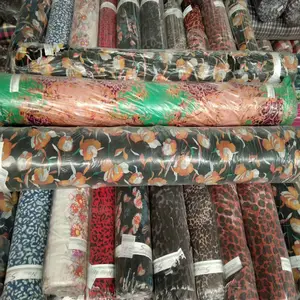
All categories
Featured selections
Trade Assurance
Buyer Central
Help Center
Get the app
Become a supplier

(18352 products available)








































A saree fabric is the material used to make the saree, an Indian traditional attire. It is a long piece of cloth, usually around six or seven yards long, draped elegantly around the body. Saree fabrics are diverse, ranging from silk to cotton, and they influence the saree's look, feel, and draping style. Here are some common types of saree materials:
Cotton Saree Fabrics
These are the most common types of saree fabrics. They are made from cotton threads and are preferred for their breathability and comfort. They are suitable for daily wear and are usually lightweight. Different types of cotton saree fabrics include:
Silk Saree Fabrics
These are made from silk threads. They are luxurious and have a natural sheen. They are suitable for formal occasions and weddings because they are rich and elegant. Different types of silk saree fabrics include:
Georgette Saree Fabrics
This saree fabric is a lightweight, crêpe fabric made from silk or polyester. It has a flowing and draping nature, which makes it popular for sarees. It is suitable for various occasions because it is versatile and elegant. Different types of georgette saree fabrics include:
Net Saree Fabrics
These are made from a lightweight, transparent material. It is often embellished with embroidery or sequins. It is suitable for formal occasions and parties because it is glamorous and elegant. Different types of net saree fabrics include:
There are various designs of saree fabrics based on different cultural backgrounds, weaving techniques, and artistic traditions. Here are some of their designs:
Saree fabrics can be worn and matched in various ways to create beautiful and elegant outfits. Here are some general tips:
Wearing tips
Wearing a saree fabric involves draping it around the body in a specific style. Traditionally, the saree is unstitched fabric that is usually 5 to 9 yards long. It is worn by women in South Asia. To wear a saree, one must first tuck one end of the fabric into their petticoat on the right side. Then, they should wrap the remaining fabric around their waist once or twice. Next, they should bring the loose end of the saree over their shoulder. Finally, they should arrange the fabric pleats in the front. Additionally, to ensure a proper fit, they should adjust the saree's height and make any necessary adjustments.
Matching tips
Matching a saree fabric with a blouse involves coordinating colors, patterns, and fabrics for a cohesive look. One should consider the saree's dominant color when selecting a blouse. Ideally, a complementary or contrasting color enhances the overall aesthetic. Also, they should take into account the saree's pattern. This is to avoid clashing with busy prints or to choose a blouse with a coordinating motif. Additionally, they should pay attention to the fabric's texture and weight. Therefore, a lightweight cotton saree pairs well with a cotton blouse. Conversely, a silk saree pairs with a silk or chiffon blouse. This enhances comfort and draping. Further, they should consider embellishments like embroidery or sequins. This ensures the blouse complements the saree's detailing. More importantly, they should test the combination by draping the saree and holding the blouse against them. This ensures a harmonious blend before making the final selection.
Q1: What are the most popular patterns and designs of saree fabrics?
A1: Some of the most popular patterns and designs of saree fabrics include intricate handwoven designs, block prints, tie and dye (bandhani), and embroidery. Each region in India has its unique patterns, such as the paisley motif in Kashmir or the geometric patterns from Gujarat. Additionally, floral and peacock designs are prevalent across many saree fabrics due to their elegance and association with Indian culture.
Q2: How does one identify the quality of saree fabrics?
A2: The quality of saree fabrics can be identified by examining the weave, texture, and finish. High-quality saree fabrics have a tight, even weave and a smooth texture. One can also check for loose threads or inconsistencies in the weave. Additionally, the fabric's drape and fall can indicate its quality; premium fabrics drape gracefully and have a luxurious feel.
Q3: Are there sustainable saree fabric options available?
A3: Yes, there are sustainable saree fabric options available. Several manufacturers and designers are creating saree fabrics using organic cotton, silk, and eco-friendly dyes. Additionally, some saree fabrics are made from recycled materials or employ sustainable weaving techniques that minimize environmental impact while supporting traditional craftsmanship.
Q4: How can one take care of different types of saree fabrics?
A4: Different types of saree fabrics require specific care to maintain their quality and longevity. Cotton sarees can be hand-washed or machine-washed in cold water with mild detergent. Silk sarees should be dry-cleaned or hand-washed in cold water with a gentle detergent to preserve the fibers. Synthetic sarees can be machine-washed in cold water. All sarees should be dried flat, away from direct sunlight, and stored in a cool, dry place to prevent damage and fading.